Effects of Aperture Shape on Absorption Property of Acoustic Metamaterial of Parallel-Connection Helmholtz Resonator
Abstract
:1. Introduction
2. Materials and Methods
2.1. Aperture for Various Shapes
2.1.1. Aperture for Various Tangent Sectional Shapes
2.1.2. Aperture for Various Cross-Sectional Shapes
2.2. Acoustic Finite Element Simulation Method
2.2.1. Two-Dimensional Model of HR with Aperture for Various Tangent Sectional Shapes
2.2.2. Three-Dimensional Model of HR with Aperture for Various Cross-Sectional Shapes
2.3. Sound Absorption Performance
2.3.1. Absorption Performance of HR with Aperture for Various Tangent Sectional Shapes
2.3.2. Absorption Performance of HR with Aperture for Various Cross-Sectional Shapes
2.3.3. Comparative Analysis of Two-Dimensional Model and Three-Dimensional Model
3. Designs and Optimizations
3.1. Structural Design
3.2. Parameter Optimization
3.3. Sample Fabrication
3.4. Sound Absorption Coefficient Measurement
4. Results and Discussions
4.1. Sound Absorption Performance
4.1.1. Comparisons of Simulation Results and Experimental Results
4.1.2. Comparisons of Absorption Properties of the Proposed Acoustic Metamaterial with Those of Multiple Parallel Connection HRs with Normal Cylindrical Aperture
4.2. Sound Absorption Mechanism
4.2.1. Absorption Mechanism of HR with Aperture for Various Tangent Sectional Shapes
4.2.2. Absorption Mechanism of HR with Aperture for Various Cross-Sectional Shapes
4.2.3. Absorption Mechanism of Multiple Parallel Connection of HRs
5. Conclusions
- (1)
- The sound absorption coefficients of HRs with apertures for various tangent sectional shapes are investigated by the two-dimensional rotational symmetric acoustic finite element model. It consists of the rectangle, common trapeziform, reverse trapeziform, dumbbell and olive. It can be concluded that the alteration of the tangent sectional shape from the traditional rectangle can shift the resonance frequency to the low-frequency direction. The HR with the aperture for the tangent sectional shape of the olive can obtain the lowest resonance frequency of 327 Hz.
- (2)
- The sound absorption properties of HRs with apertures for various cross-sectional shapes is studied by the three-dimensional acoustic finite element model. It includes the round, regular triangle, square, regular pentagon and regular hexagon. It has been proved that the HR with the aperture for the cross-sectional shape of the round can achieve the lowest resonance frequency. That is why most apertures in the acoustic metamaterials apply the cross-sectional shapes of a round.
- (3)
- The sound absorption performance gained by the two-dimensional model is consistent with that achieved by the three-dimensional model with the same geometric parameters. It indicates that the two-dimensional model can be used to determine the initial values of geometric parameters, and the three-dimensional model can be applied to identify the optimal parameters accurately. It is favorable to improve the calculation and optimization efficiency for the development of some acoustic metamaterial with certain constraint conditions.
- (4)
- The acoustic metamaterial of multiple parallel connection of the HRs with apertures for the tangent sectional shape of the olive and the cross-sectional shape of the round is optimized by the cuckoo search algorithm. The samples are prepared by the low-force stereolithography 3D printer Form3 and detected by the AWA6290T transfer function impedance tube detector. The actual average sound absorption coefficient of 0.7821 in the frequency range of 500–820 Hz is obtained with a limited thickness of 30 mm. It exhibits a satisfactory and relatively homogeneous sound absorption performance to meet the requirement of noise reduction for the given application scenario.
- (5)
- The sound absorption mechanism of HRs with apertures for various tangent sectional shapes and that of HRs with apertures for various cross-sectional shapes are investigated by the distributions of sound pressure, acoustic velocity and temperature at these resonance frequencies. The achieved characteristics are consistent with the normal sound absorption mechanism for the multiple parallel connection of HRs. They can certify the correctness of this study about the effects of tangent- and cross-sectional shapes of the aperture on the sound absorption performance of HRs.
Author Contributions
Funding
Institutional Review Board Statement
Informed Consent Statement
Data Availability Statement
Conflicts of Interest
References
- Dogra, S.; Gupta, A. Design, Manufacturing, and Acoustical Analysis of a Helmholtz Resonator–Based Metamaterial Plate. Acoustics 2021, 3, 630–641. [Google Scholar] [CrossRef]
- Yang, F.; Wang, E.; Shen, X.; Zhang, X.; Yin, Q.; Wang, X.; Yang, X.; Shen, C.; Peng, W. Optimal Design of Acoustic Metamaterial of Multiple Parallel Hexagonal Helmholtz Resonators by Combination of Finite Element Simulation and Cuckoo Search Algorithm. Materials 2022, 15, 6450. [Google Scholar] [CrossRef] [PubMed]
- Cai, C.; Mak, C.M.; Wang, X. Noise attenuation performance improvement by adding Helmholtz resonators on the periodic ducted Helmholtz resonator system. Appl. Acoust. 2017, 122, 8–15. [Google Scholar] [CrossRef]
- Duan, H.; Yang, F.; Shen, X.; Yin, Q.; Wang, E.; Zhang, X.; Yang, X.; Shen, C.; Peng, W. Acoustic Metamaterials for Low-Frequency Noise Reduction Based on Parallel Connection of Multiple Spiral Chambers. Materials 2022, 15, 3882. [Google Scholar] [CrossRef]
- Mao, Q.; Li, S.; Liu, W. Development of a sweeping Helmholtz resonator for noise control. Appl. Acoust. 2018, 141, 348–354. [Google Scholar] [CrossRef]
- Herrero–Durá, I.; Cebrecos, A.; Picó, R.; Romero–García, V.; García–Raffi, L.M.; Sánchez–Morcillo, V.J. Sound Absorption and Diffusion by 2D Arrays of Helmholtz Resonators. Appl. Sci. 2020, 10, 1690. [Google Scholar] [CrossRef]
- Yang, X.; Yang, F.; Shen, X.; Wang, E.; Zhang, X.; Shen, C.; Peng, W. Development of Adjustable Parallel Helmholtz Acoustic Metamaterial for Broad Low-Frequency Sound Absorption Band. Materials 2022, 15, 5938. [Google Scholar] [CrossRef]
- Shi, X.; Mak, C.M. Helmholtz resonator with a spiral neck. Appl. Acoust. 2015, 99, 68–71. [Google Scholar] [CrossRef]
- Xu, M.; Selamet, A.; Kim, H. Dual Helmholtz resonator. Appl. Acoust. 2010, 71, 822–829. [Google Scholar] [CrossRef]
- Kim, H.; Selamet, A. Effect of flow on a dual Helmholtz resonator. J. Mech. Sci. Technol. 2020, 34, 581–588. [Google Scholar] [CrossRef]
- Komkin, A.I.; Mironov, M.A.; Bykov, A.I. Sound absorption by a Helmholtz resonator. Acoust. Phys. 2017, 63, 385–392. [Google Scholar] [CrossRef]
- Langfeldt, F.; Hoppen, H.; Gleine, W. Resonance frequencies and sound absorption of Helmholtz resonators with multiple necks. Appl. Acoust. 2018, 145, 314–319. [Google Scholar] [CrossRef]
- Wang, X.; Mak, C.-M. Disorder in a periodic Helmholtz resonators array. Appl. Acoust. 2014, 82, 1–5. [Google Scholar] [CrossRef]
- Biswas, S.; Agrawal, A. Noise reduction in a large enclosure using single, dual and ensconced Helmholtz resonators. Curr. Sci. India 2013, 104, 1681–1691. [Google Scholar]
- Chen, J.-S.; Chen, Y.-B.; Cheng, Y.-H.; Chou, L.-C. A sound absorption panel containing coiled Helmholtz resonators. Phys. Lett. A 2020, 384, 126887. [Google Scholar] [CrossRef]
- Zhang, J.; Chen, T.; Xin, F.; Zhu, J.; Ding, W. New-parallel connection of the Helmholtz resonator with embedded apertures for low-frequency broadband sound absorption. Jpn. J. Appl. Phys. 2022, 61, 077001. [Google Scholar] [CrossRef]
- Wei, W.; Ren, S.; Chronopoulos, D.; Meng, H. Optimization of connection architectures and mass distributions for metamaterials with multiple resonators. J. Appl. Phys. 2021, 129, 165101. [Google Scholar] [CrossRef]
- Wang, E.; Yang, F.; Shen, X.; Duan, H.; Zhang, X.; Yin, Q.; Peng, W.; Yang, X.; Yang, L. Development and Optimization of Broadband Acoustic Metamaterial Absorber Based on Parallel–Connection Square Helmholtz Resonators. Materials 2022, 15, 3417. [Google Scholar] [CrossRef]
- Chiu, M.-C. Numerical assessment for a broadband and tuned noise using hybrid mufflers and a simulated annealing method. J. Sound Vib. 2013, 332, 2923–2940. [Google Scholar] [CrossRef]
- Song, C.; Zhao, J.; Ma, X.; Zhang, M.; Yuan, W.; Yang, F.; Wang, Z.; Zhang, X.; Pan, Y. Multi-frequency sound energy harvesting using Helmholtz resonators with irradiated cross-linked polypropylene ferroelectret films. AIP Adv. 2021, 11, 115002. [Google Scholar] [CrossRef]
- Casarini, C.; Tiller, B.; Mineo, C.; Macleod, C.N.; Windmill, J.F.C.; Jackson, J.C. Enhancing the Sound Absorption of Small-Scale 3-D Printed Acoustic Metamaterials Based on Helmholtz Resonators. IEEE Sensors J. 2018, 18, 7949–7955. [Google Scholar] [CrossRef] [Green Version]
- Zigoneanu, L.; Popa, B.-I.; Cummer, S.A. Design and measurements of a broadband two-dimensional acoustic lens. Phys. Rev. B 2011, 84, 024305. [Google Scholar] [CrossRef]
- Cai, C.; Mak, C.M. Noise attenuation capacity of a Helmholtz resonator. Adv. Eng. Softw. 2018, 116, 60–66. [Google Scholar] [CrossRef]
- Yan, W.; Yan, S.; Li, B.; Li, Y. Experiment-simulation Study on Noise Reduction of Cylinder Shell with Horn Helmholtz Resonator. Teh. Vjesn. Tech. Gaz. 2020, 27, 142–148. [Google Scholar] [CrossRef]
- Wu, D.; Zhang, N.; Mak, C.M.; Cai, C. Hybrid noise control using multiple Helmholtz resonator arrays. Appl. Acoust. 2018, 143, 31–37. [Google Scholar] [CrossRef]
- Wu, D.; Zhang, N.; Mak, C.M.; Cai, C. Noise Attenuation Performance of a Helmholtz Resonator Array Consist of Several Periodic Parts. Sensors 2017, 17, 1029. [Google Scholar] [CrossRef]
- Mahesh, K.; Mini, R.S. Theoretical investigation on the acoustic performance of Helmholtz resonator integrated microper-forated panel absorber. Appl. Acoust. 2021, 178, 108012. [Google Scholar] [CrossRef]
- Bai, C.; Wu, F.; Wang, J.; Jiang, J.; Yang, B. A broadband low-frequency muffler based on neural network method and Helmholtz resonator with helical neck. J. Vib. Control. 2022, 10775463221107197. [Google Scholar] [CrossRef]
- Sun, W.; Li, L.; Chu, Z.P.; Li, L.Y.; Fan, X.P. A parameter design method for multifrequency perfect sound–absorbing metasurface with critical coupled Helmholtz resonator. J. Low Freq. Noise Vib. Act. Control. 2021, 40, 2054–2063. [Google Scholar]
- Cheng, X.; Chen, X.; Rong, J.; Fan, B.; Nisu, A. Low-Frequency Noise Reduction of Rocket Fairings Using Horn-Shaped-Neck Helmholtz Resonators. J. Spacecr. Rocket. 2019, 56, 273–282. [Google Scholar] [CrossRef]
- Shen, X.; Bai, P.; Yang, X.; Zhang, X.; To, S. Low Frequency Sound Absorption by Optimal Combination Structure of Porous Metal and Microperforated Panel. Appl. Sci. 2019, 9, 1507. [Google Scholar] [CrossRef]
- Yang, X.; Shen, X.; Bai, P.; He, X.; Zhang, X.; Li, Z.; Chen, L.; Yin, Q. Preparation and Characterization of Gradient Compressed Porous Metal for High-Efficiency and Thin-Thickness Acoustic Absorber. Materials 2019, 12, 1413. [Google Scholar] [CrossRef] [PubMed] [Green Version]
- Yang, X.; Bai, P.; Shen, X.; To, S.; Chen, L.; Zhang, X.; Yin, Q. Optimal design and experimental validation of sound absorbing multilayer microperforated panel with constraint conditions. Appl. Acoust. 2018, 146, 334–344. [Google Scholar] [CrossRef]
- Yang, X.; Shen, X.; Duan, H.; Yang, F.; Zhang, X.; Pan, M.; Yin, Q. Improving and Optimizing Sound Absorption Performance of Polyurethane Foam by Prepositive Microperforated Polymethyl Methacrylate Panel. Appl. Sci. 2020, 10, 2103. [Google Scholar] [CrossRef]
- Wang, E.; Yang, F.; Shen, X.; Li, Z.; Yang, X.; Zhang, X.; Peng, W. Investigation and Optimization of the Impact of Printing Orientation on Mechanical Properties of Resin Sample in the Low-Force Stereolithography Additive Manufacturing. Materials 2022, 15, 6743. [Google Scholar] [CrossRef]
- Zhao, Y.; Xu, J.; Davy, J.L.; Liu, Z.; Fard, M. Prediction of random incidence sound absorption coefficients of porous materials. Appl. Acoust. 2022, 189, 108625. [Google Scholar] [CrossRef]
- Cobo, P. A model comparison of the absorption coefficient of a Microperforated Insertion Unit in the frequency and time domains. Appl. Acoust. 2008, 69, 40–46. [Google Scholar] [CrossRef]
- Hirosawa, K.; Takashima, K.; Nakagawa, H.; Kon, M.; Yamamoto, A.; Lauriks, W. Comparison of three measurement tech-niques for the normal absorption coefficient of sound absorbing materials in the free field. J. Acoust. Soc. Am. 2009, 126, 3020–3027. [Google Scholar] [CrossRef]
- Yang, F.; Shen, X.; Bai, P.; Zhang, X.; Li, Z.; Yin, Q. Optimization and Validation of Sound Absorption Performance of 10-Layer Gradient Compressed Porous Metal. Metals 2019, 9, 588. [Google Scholar] [CrossRef]
- Hedayati, R.; Lakshmanan, S. Pneumatically-Actuated Acoustic Metamaterials Based on Helmholtz Resonators. Materials 2020, 13, 1456. [Google Scholar] [CrossRef]
- Gebrekidan, S.B.; Kim, H.-J.; Song, S.-J. Investigation of Helmholtz resonator-based composite acoustic metamaterial. Appl. Phys. A 2019, 125, 65. [Google Scholar] [CrossRef]
- Duan, H.; Shen, X.; Yang, F.; Bai, P.; Lou, X.; Li, Z. Parameter Optimization for Composite Structures of Microperforated Panel and Porous Metal for Optimal Sound Absorption Performance. Appl. Sci. 2019, 9, 4798. [Google Scholar] [CrossRef] [Green Version]
- Yang, F.; Bi, S.; Shen, X.; Li, Z.; Zhang, X.; Wang, E.; Yang, X.; Peng, W.; Huang, C.; Liang, P.; et al. Adjustable Sound Absorber of Multiple Parallel-Connection Helmholtz Resonators with Tunable Apertures Prepared by Low-Force Stereolithography of Photopolymer Resin. Polymers 2022, 14, 5434. [Google Scholar] [CrossRef] [PubMed]


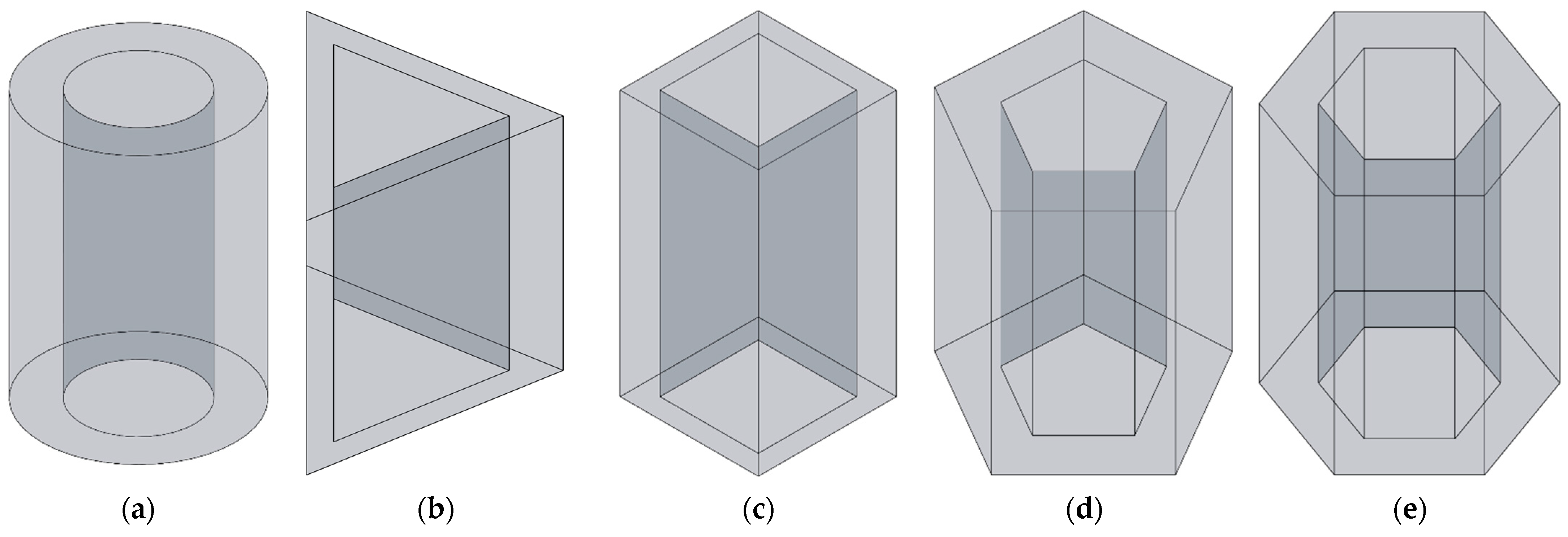


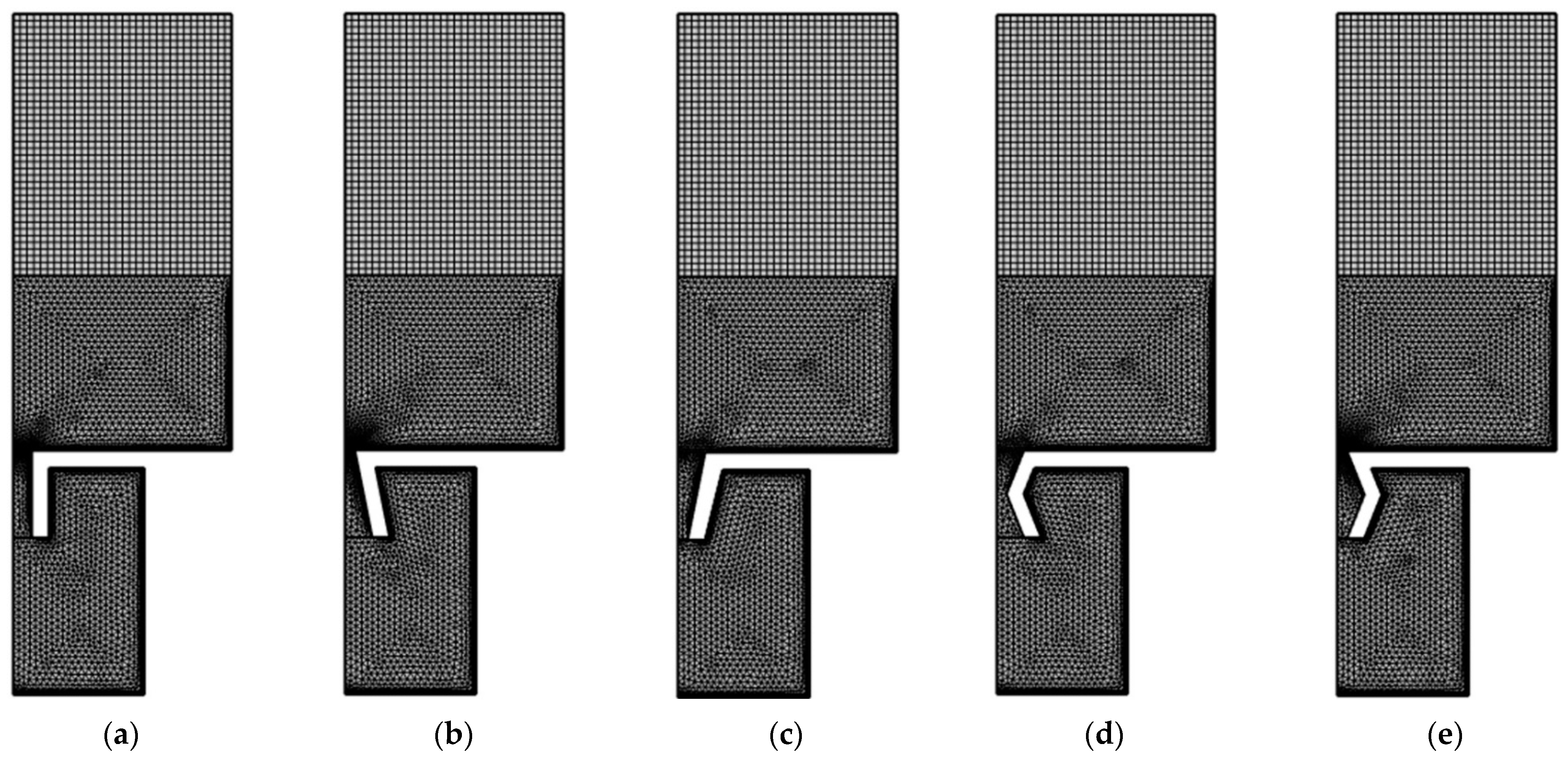



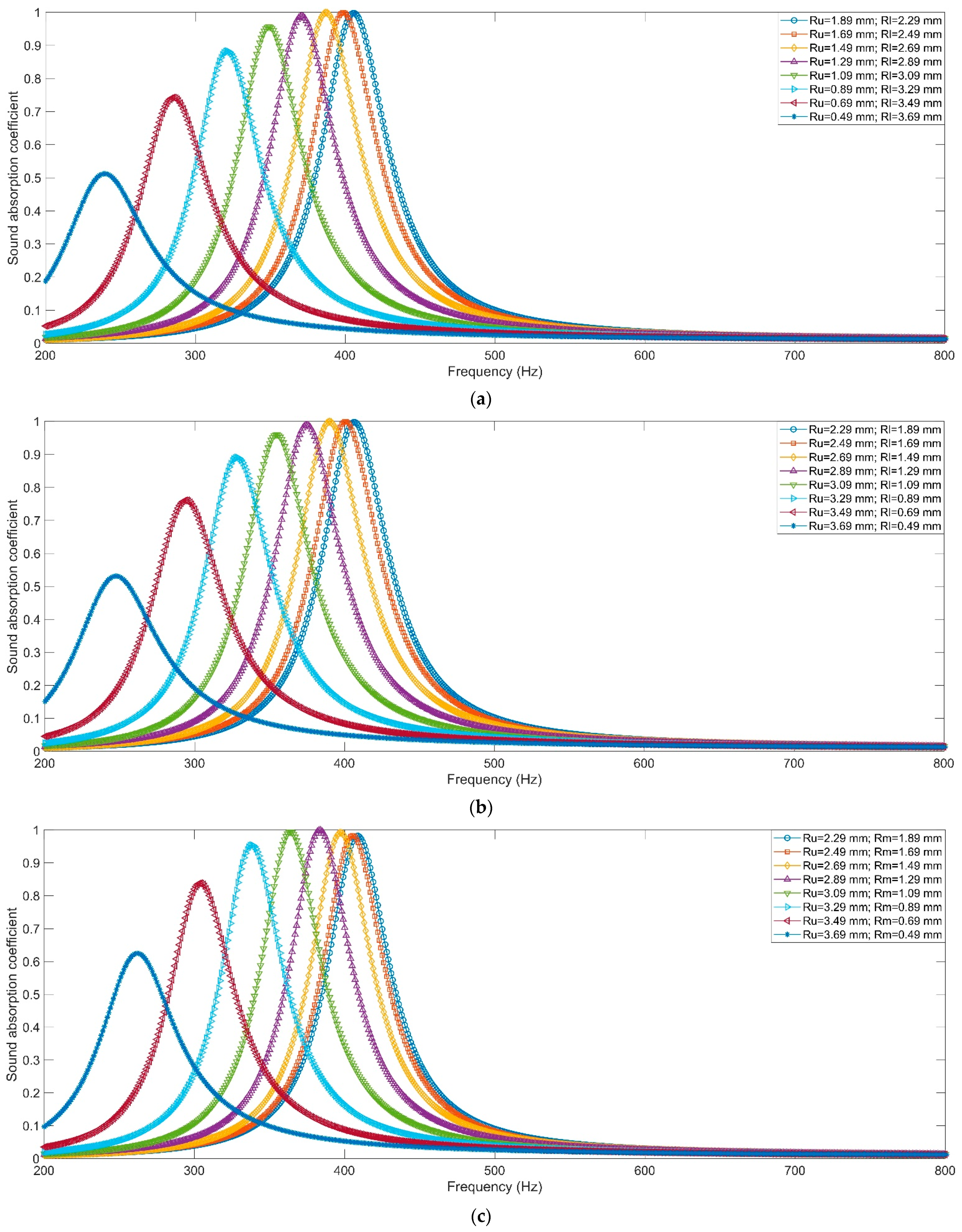

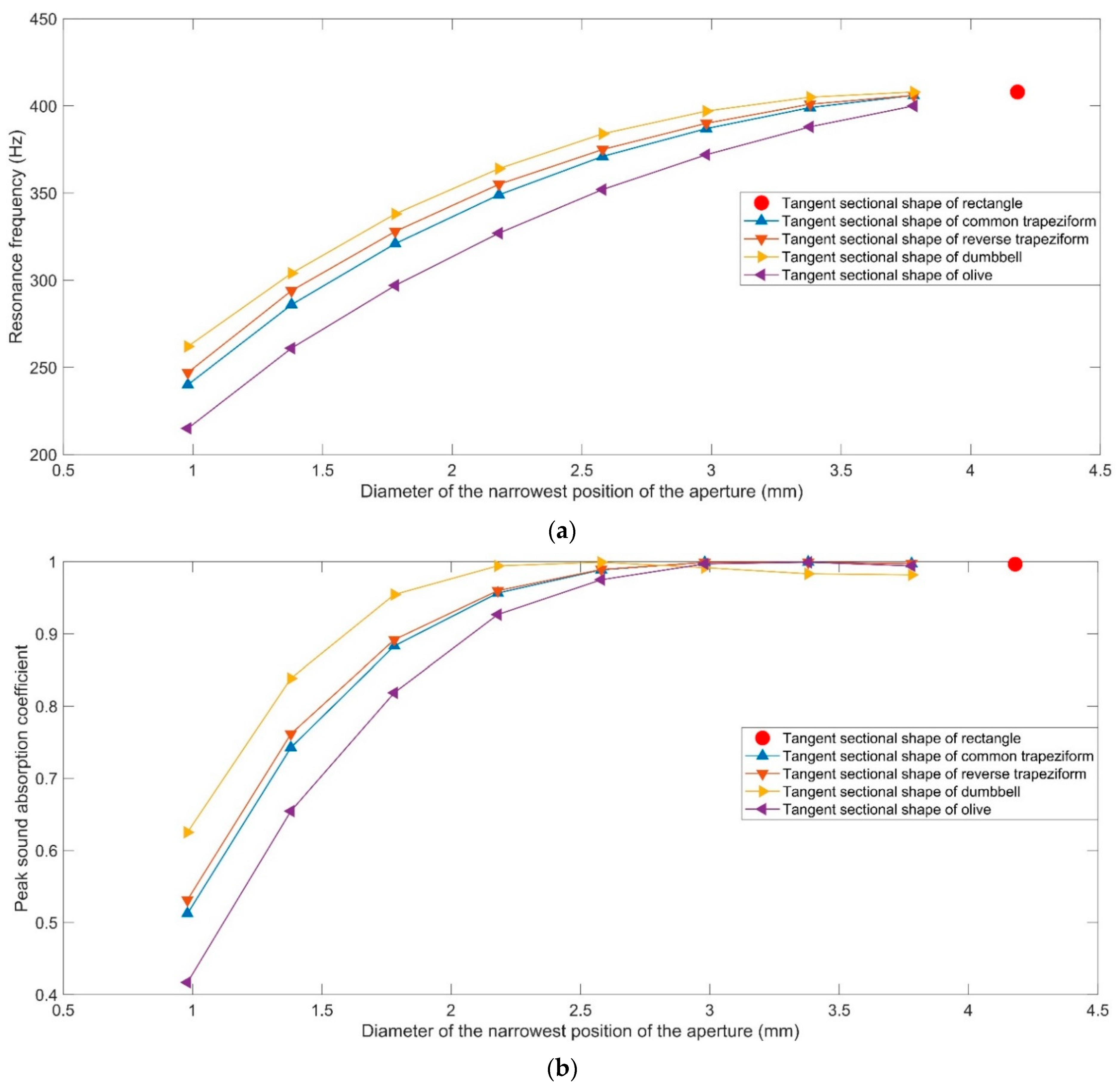
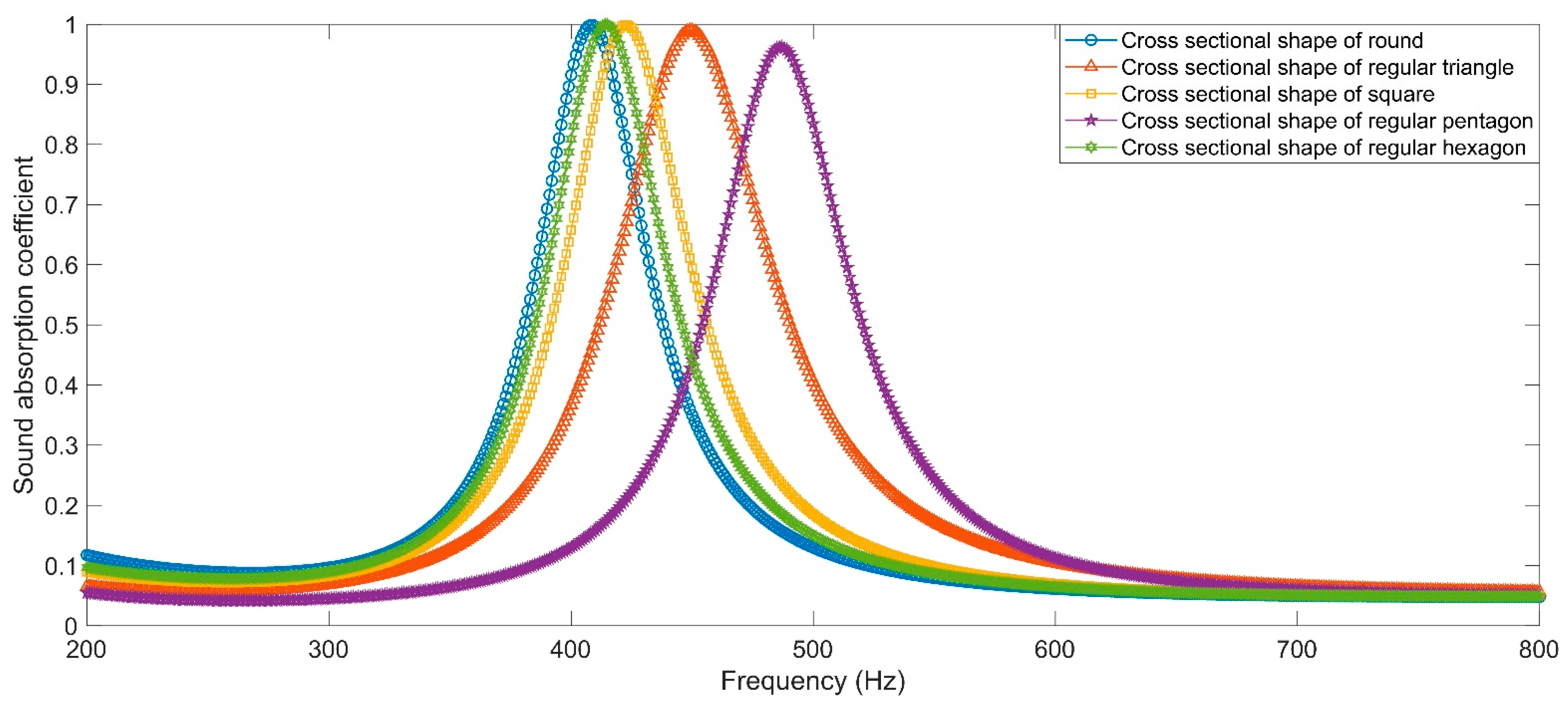
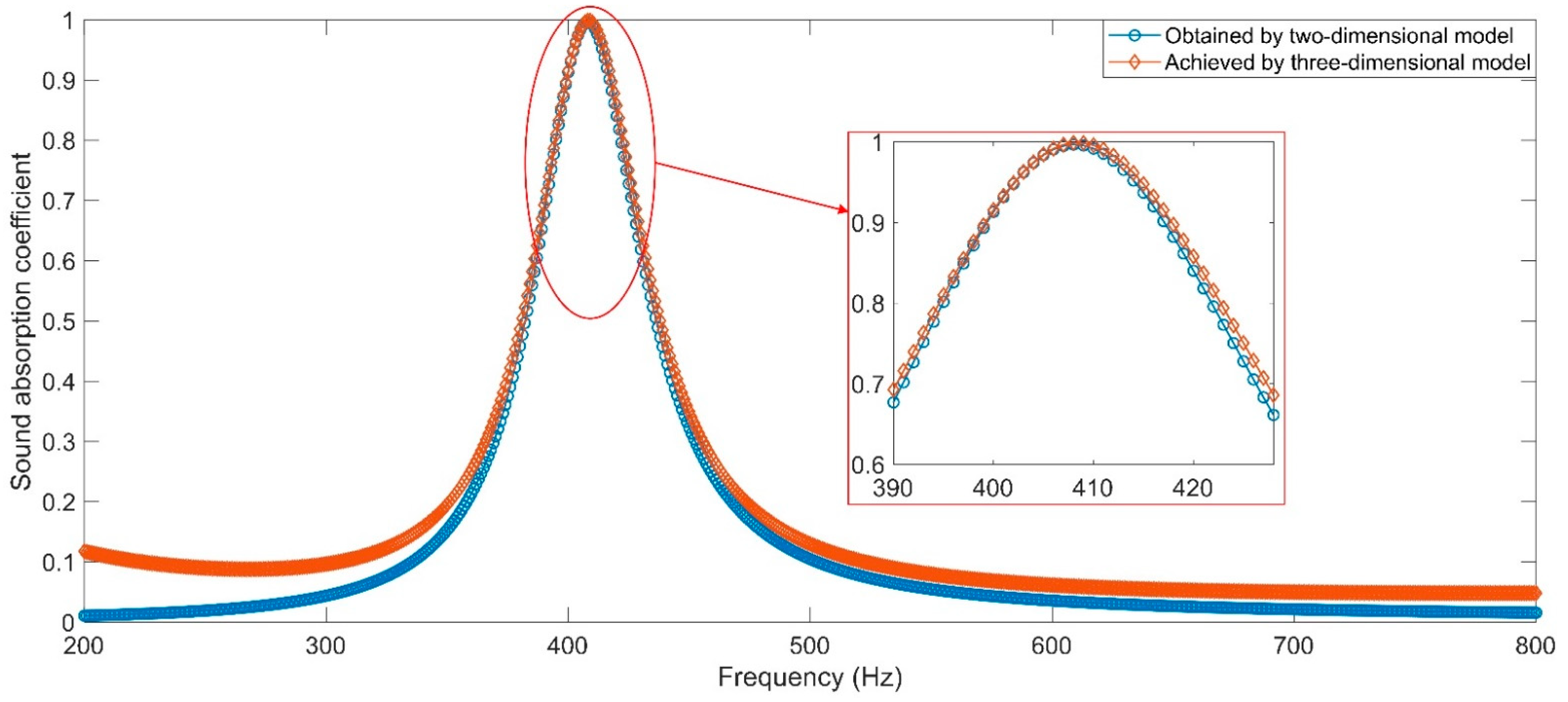


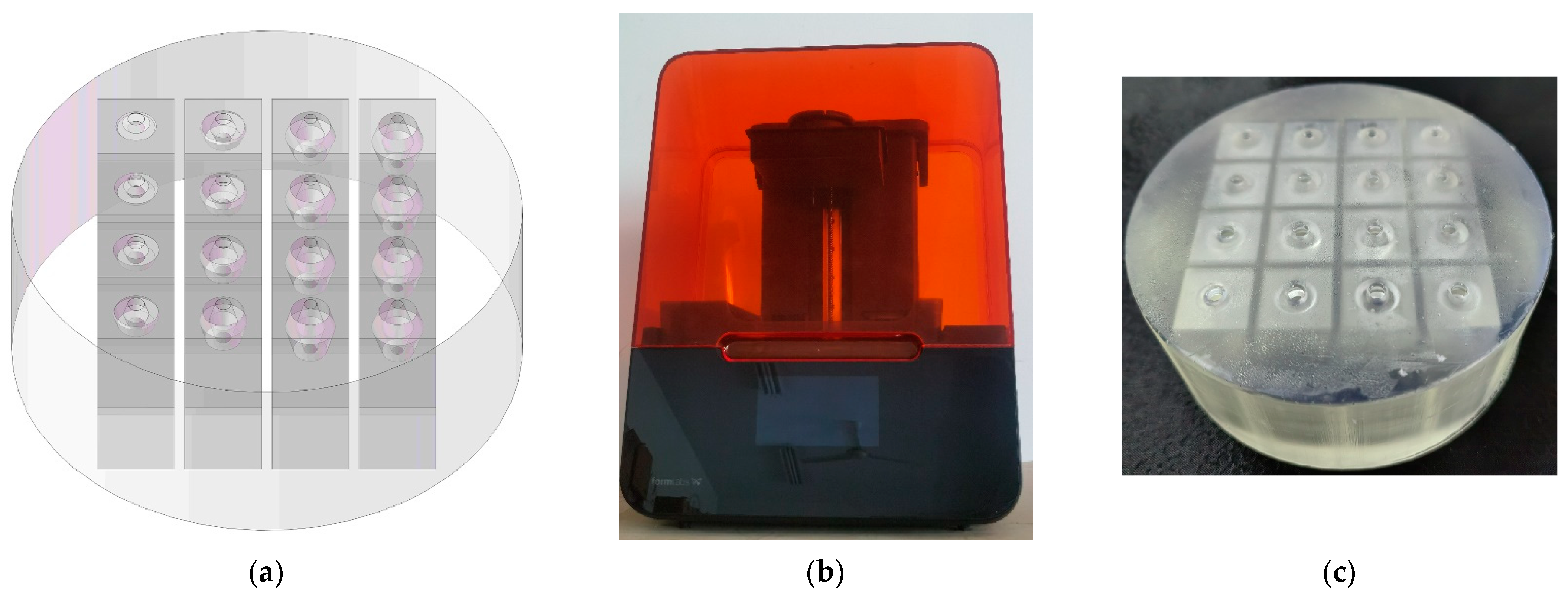
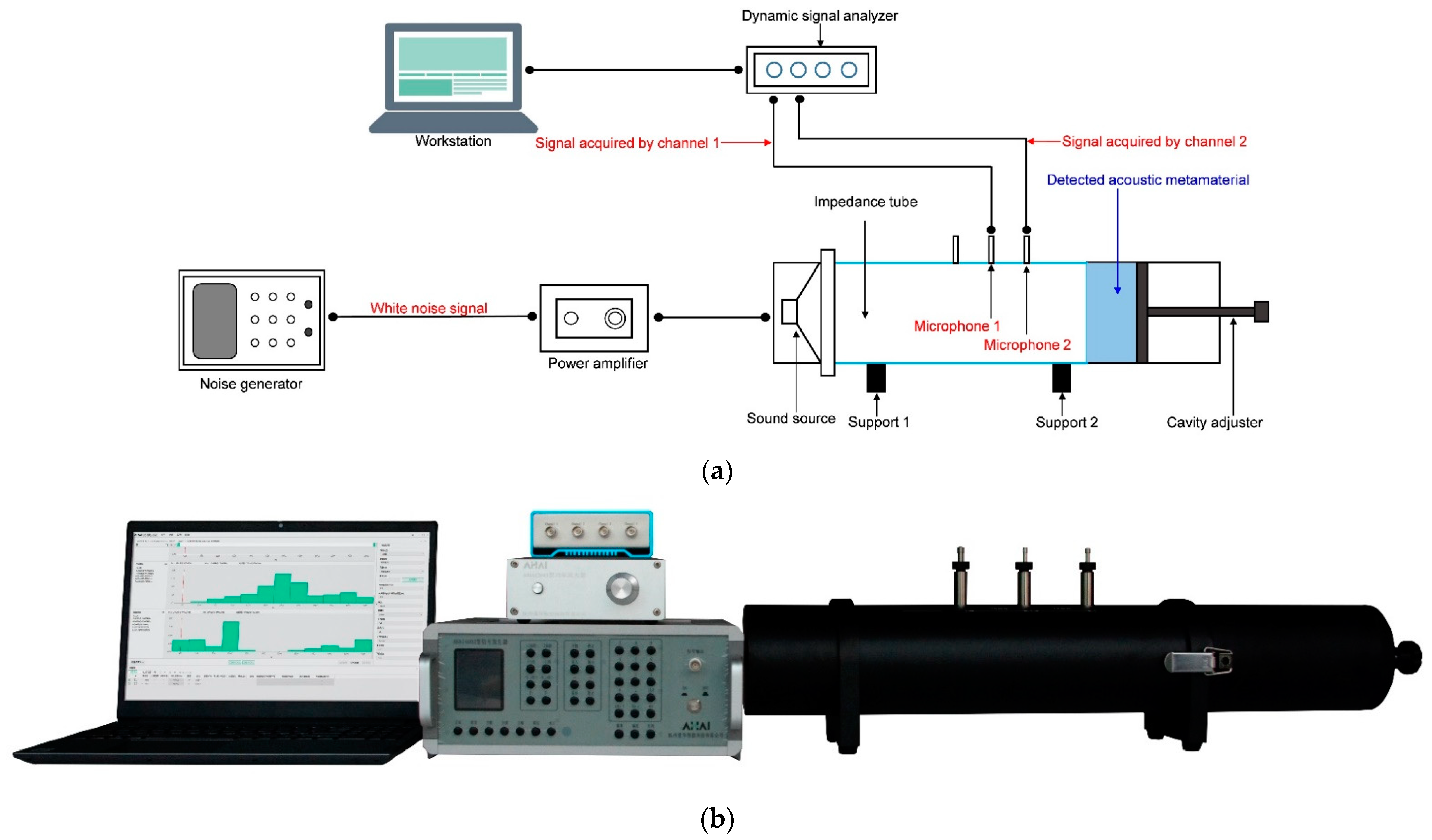

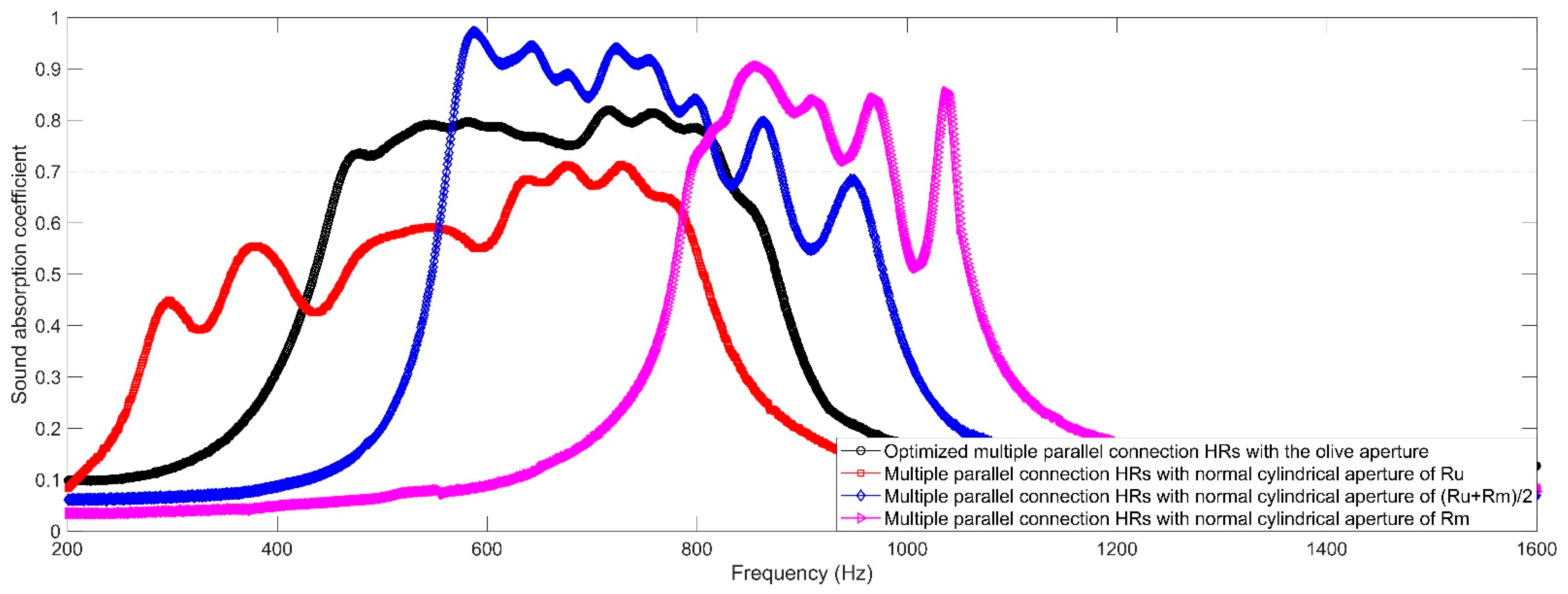








| Parameters | Parameters of Model for the HRs with Aperture for Various Tangent Sectional Shapes | ||||
|---|---|---|---|---|---|
| Rectangle | Common Trapeziform | Reverse Trapeziform | Dumbbell | Olive | |
| Radius of the upper plane Ru | 2.09 mm | 1.09 mm | 3.09 mm | 3.09 mm | 1.09 mm |
| Radius of the middle plane Rm | 2.09 mm | 2.09 mm | 2.09 mm | 1.09 mm | 3.09 mm |
| Radius of the lower plane Rl | 2.09 mm | 3.09 mm | 1.09 mm | 3.09 mm | 1.09 mm |
| Length of the aperture l | 10 mm | ||||
| Thickness of the cavity T | 26 mm | ||||
| Diameter of the cavity D | 30 mm | ||||
| Thickness of the panel t | 2 mm | ||||
| Diameter of the BAF DD | 50 mm | ||||
| Thickness of the BAF LL | 20 mm | ||||
| Perforation ratio σ | 0.7% | ||||
| Ru | Rm | Rl | L | Ru | Rm | Rl | L | Ru | Rm | Rl | L | Ru | Rm | Rl | L | ||||
|---|---|---|---|---|---|---|---|---|---|---|---|---|---|---|---|---|---|---|---|
| H01 | 1.69 | 2.49 | 1.69 | 2.3 | H05 | 1.49 | 2.69 | 1.49 | 5.2 | H09 | 1.29 | 2.89 | 1.29 | 9.4 | H13 | 1.09 | 3.09 | 1.09 | 12.4 |
| H02 | 1.69 | 2.49 | 1.69 | 3.1 | H06 | 1.49 | 2.69 | 1.49 | 6.4 | H10 | 1.29 | 2.89 | 1.29 | 10.2 | H14 | 1.09 | 3.09 | 1.09 | 12.5 |
| H03 | 1.69 | 2.49 | 1.69 | 4.2 | H07 | 1.49 | 2.69 | 1.49 | 7.8 | H11 | 1.29 | 2.89 | 1.29 | 11.4 | H15 | 1.09 | 3.09 | 1.09 | 12.6 |
| H04 | 1.69 | 2.49 | 1.69 | 5.3 | H08 | 1.49 | 2.69 | 1.49 | 9.2 | H12 | 1.29 | 2.89 | 1.29 | 12.4 | H16 | 1.09 | 3.09 | 1.09 | 12.7 |
Disclaimer/Publisher’s Note: The statements, opinions and data contained in all publications are solely those of the individual author(s) and contributor(s) and not of MDPI and/or the editor(s). MDPI and/or the editor(s) disclaim responsibility for any injury to people or property resulting from any ideas, methods, instructions or products referred to in the content. |
© 2023 by the authors. Licensee MDPI, Basel, Switzerland. This article is an open access article distributed under the terms and conditions of the Creative Commons Attribution (CC BY) license (https://creativecommons.org/licenses/by/4.0/).
Share and Cite
Bi, S.; Yang, F.; Tang, S.; Shen, X.; Zhang, X.; Zhu, J.; Yang, X.; Peng, W.; Yuan, F. Effects of Aperture Shape on Absorption Property of Acoustic Metamaterial of Parallel-Connection Helmholtz Resonator. Materials 2023, 16, 1597. https://doi.org/10.3390/ma16041597
Bi S, Yang F, Tang S, Shen X, Zhang X, Zhu J, Yang X, Peng W, Yuan F. Effects of Aperture Shape on Absorption Property of Acoustic Metamaterial of Parallel-Connection Helmholtz Resonator. Materials. 2023; 16(4):1597. https://doi.org/10.3390/ma16041597
Chicago/Turabian StyleBi, Shaohua, Fei Yang, Shuai Tang, Xinmin Shen, Xiaonan Zhang, Jingwei Zhu, Xiaocui Yang, Wenqiang Peng, and Feng Yuan. 2023. "Effects of Aperture Shape on Absorption Property of Acoustic Metamaterial of Parallel-Connection Helmholtz Resonator" Materials 16, no. 4: 1597. https://doi.org/10.3390/ma16041597





